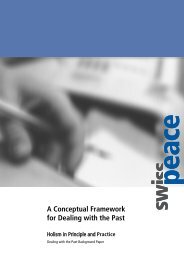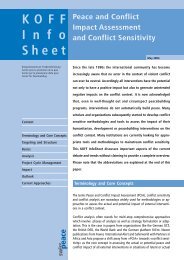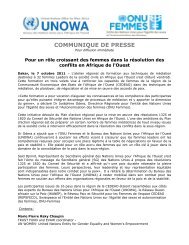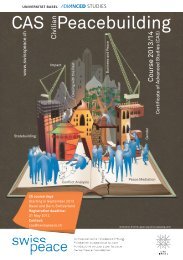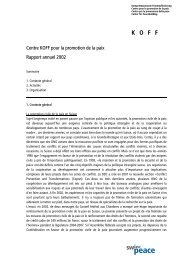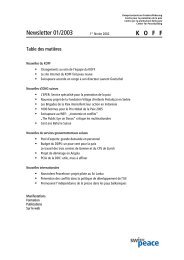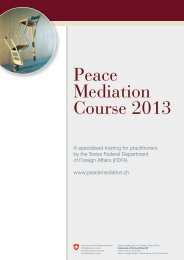Unpacking the Mystery of Mediation in African Peace ... - Swisspeace
Unpacking the Mystery of Mediation in African Peace ... - Swisspeace
Unpacking the Mystery of Mediation in African Peace ... - Swisspeace
Create successful ePaper yourself
Turn your PDF publications into a flip-book with our unique Google optimized e-Paper software.
Côte d’Ivoire, Ouagadougou Agreement<br />
Gbagbo (<strong>the</strong> L<strong>in</strong>a-Marcoussis-Agreement had<br />
been signed by seven major delegations and additional<br />
small parties). More importantly, direct<br />
talks were held between Soro and <strong>the</strong> government,<br />
<strong>the</strong> latter be<strong>in</strong>g represented at <strong>the</strong> table by<br />
M<strong>in</strong>ister <strong>of</strong> <strong>the</strong> Interior Désiré Tagro.<br />
<strong>Mediation</strong> Team and Third-Party<br />
Coord<strong>in</strong>ation<br />
Three mediators were <strong>in</strong>volved: Djibril Yipènè<br />
Bassolé, at that time m<strong>in</strong>ister <strong>of</strong> security <strong>of</strong> Burk<strong>in</strong>a<br />
Faso; <strong>the</strong> legal councilor <strong>of</strong> <strong>the</strong> president <strong>of</strong><br />
Burk<strong>in</strong>a Faso; and Mario Giro from <strong>the</strong> community<br />
<strong>of</strong> Sant’Egidio. In difficult situations, all <strong>the</strong><br />
mediators and participants went to President<br />
Compaoré. M<strong>in</strong>ister Bassolé acted as <strong>the</strong> head <strong>of</strong><br />
<strong>the</strong> mediat<strong>in</strong>g team dur<strong>in</strong>g <strong>the</strong> sessions.<br />
<strong>Mediation</strong> Style and Strategy 77<br />
Previous attempts had been characterized by external<br />
pressure and <strong>the</strong> imposition <strong>of</strong> solutions. 78<br />
Mario Giro describes <strong>the</strong> activities <strong>of</strong> <strong>the</strong> GTI on<br />
<strong>the</strong> eve <strong>of</strong> <strong>the</strong> Ouagadougou talks as expropriation<br />
<strong>of</strong> <strong>the</strong> Ivorians with regard to <strong>the</strong>ir peace<br />
process. By contrast, accord<strong>in</strong>g to Mario Giro,<br />
<strong>the</strong>re was no pressure ei<strong>the</strong>r from <strong>in</strong>ternational<br />
actors or from <strong>the</strong> lead or assist<strong>in</strong>g mediators <strong>in</strong><br />
<strong>the</strong> Ouagadougou talks. 79 This mediation differed<br />
essentially from o<strong>the</strong>r mediation attempts, as <strong>the</strong><br />
mediators absta<strong>in</strong>ed from <strong>in</strong>terven<strong>in</strong>g <strong>in</strong> <strong>the</strong> substance,<br />
and <strong>the</strong> negotiations took place directly<br />
between <strong>the</strong> two parties’ leaders. Therefore, <strong>the</strong><br />
entire responsibility rested upon <strong>the</strong>se two leaders.<br />
Dur<strong>in</strong>g <strong>the</strong> sessions, <strong>the</strong>re was no need for<br />
ground rules. For most <strong>of</strong> <strong>the</strong> time, <strong>the</strong> three mediators<br />
were just sitt<strong>in</strong>g <strong>in</strong> <strong>the</strong> room and watch<strong>in</strong>g<br />
<strong>the</strong> delegations “shout<strong>in</strong>g at each o<strong>the</strong>r”, <strong>in</strong>dicat<strong>in</strong>g<br />
that <strong>the</strong> parties were responsible for <strong>the</strong>ir actions:<br />
“ ‘If you want to reach an agreement, do so;<br />
we are here to assist you, and we don’t need to be<br />
here.’ If you put th<strong>in</strong>gs like this, <strong>the</strong> parties feel<br />
77 The follow<strong>in</strong>g description <strong>of</strong> <strong>the</strong> mediation style and thirdparty<br />
coord<strong>in</strong>ation is based on a conversation <strong>of</strong> <strong>the</strong> author with<br />
Mario Giro (22 July 2008).<br />
78 See, for <strong>in</strong>stance, <strong>the</strong> declaration <strong>of</strong> France on 30 January 2006<br />
(http://www.doc.diplomatie.gouv.fr).<br />
79 Interview with Mario Giro (2 August 2007): “Personne ne doit<br />
se sentir exclu.”<br />
<strong>the</strong> responsibility and stop play<strong>in</strong>g games.” 80 This<br />
sense <strong>of</strong> responsibility had been miss<strong>in</strong>g <strong>in</strong> previous<br />
mediation attempts.<br />
There was no deadl<strong>in</strong>e, and <strong>the</strong> two parties were<br />
free to reach whatever outcome <strong>the</strong>y had <strong>in</strong> m<strong>in</strong>d.<br />
Fur<strong>the</strong>rmore, <strong>the</strong> mediat<strong>in</strong>g team did not take<br />
<strong>the</strong> <strong>in</strong>itiative with regard to putt<strong>in</strong>g documents<br />
on <strong>the</strong> table. The parties <strong>the</strong>mselves drafted <strong>the</strong><br />
relevant documents separately. Subsequently, <strong>the</strong><br />
mediators put <strong>the</strong> positions toge<strong>the</strong>r and gave <strong>the</strong><br />
result<strong>in</strong>g document back to <strong>the</strong> parties for fur<strong>the</strong>r<br />
discussion. Formulation and suggestions were<br />
rarely applied. One element <strong>in</strong> <strong>the</strong> agreement that<br />
goes back to a suggestion by <strong>the</strong> mediation team<br />
is a code <strong>of</strong> conduct for <strong>the</strong> implementation<br />
phase. This code was formulated jo<strong>in</strong>tly between<br />
<strong>the</strong> parties and <strong>the</strong> mediators. This ‘nonthreaten<strong>in</strong>g’<br />
mediation is certa<strong>in</strong>ly an example for<br />
facilitative, low-powered mediation.<br />
Negotiation Setup and Process<br />
The negotiation set-up <strong>of</strong> <strong>the</strong> talks reflected <strong>the</strong><br />
facilitative approach used. The confidential atmosphere<br />
<strong>in</strong> <strong>the</strong> conference hotel was ensured by<br />
limit<strong>in</strong>g contact to journalists and reduc<strong>in</strong>g <strong>the</strong><br />
total number <strong>of</strong> persons <strong>in</strong>volved <strong>in</strong> <strong>the</strong> organization<br />
and chair<strong>in</strong>g <strong>of</strong> <strong>the</strong> meet<strong>in</strong>gs to a maximum<br />
<strong>of</strong> ten persons. Only <strong>the</strong> three mediators were<br />
constantly <strong>in</strong> <strong>the</strong> room with <strong>the</strong> parties. No audience<br />
was allowed, s<strong>in</strong>ce spectators would undoubtedly<br />
have <strong>in</strong>creased <strong>the</strong> sense <strong>of</strong> pressure<br />
and <strong>of</strong> be<strong>in</strong>g ‘observed’. The smaller <strong>the</strong> sett<strong>in</strong>g,<br />
<strong>the</strong> easier it is also for <strong>the</strong> negotiators to test ideas<br />
without be<strong>in</strong>g bound to <strong>the</strong>m by an audience.<br />
The talks were partly conducted directly between<br />
Soro and Tagro, who was <strong>in</strong> constant contact<br />
with Gbagbo, and partly <strong>in</strong> separate meet<strong>in</strong>gs<br />
with <strong>the</strong> mediators. In a first phase (approximately<br />
from 5–24 February 2007), <strong>the</strong> two delegations<br />
held separate talks, with <strong>the</strong> facilitators<br />
act<strong>in</strong>g as go-betweens. In a second phase (20 February<br />
– 4 March), both delegations met directly.<br />
The discussions took place <strong>in</strong> a confidential atmosphere,<br />
with <strong>the</strong> aim <strong>of</strong> ma<strong>in</strong>ta<strong>in</strong><strong>in</strong>g <strong>the</strong> par-<br />
80 Mario Giro (22 July 2008). From a social psychological perspective,<br />
this approach complies with <strong>the</strong> basic preconditions<br />
for a shift <strong>in</strong> attitude or perception. Commitment and recognition<br />
must be achieved without pressure <strong>in</strong> order to create cognitive<br />
dissonance, which <strong>in</strong> turn <strong>in</strong>itiates shifts <strong>in</strong> perception.<br />
37




